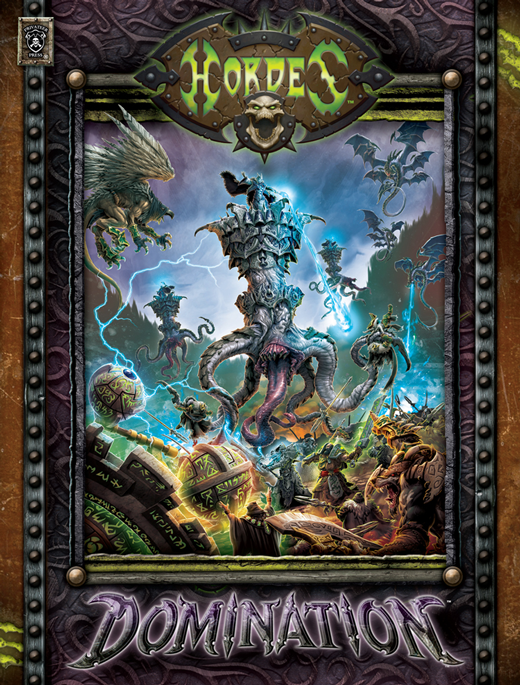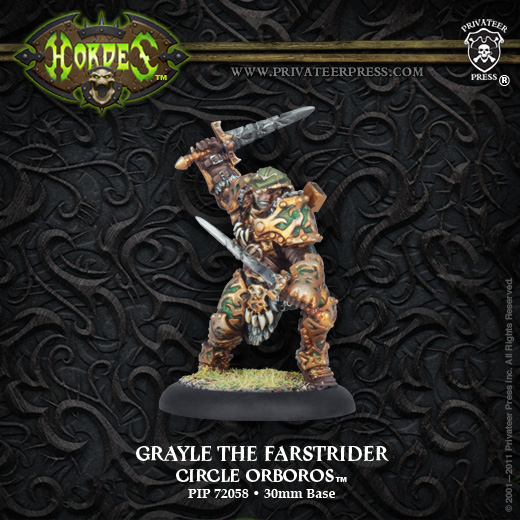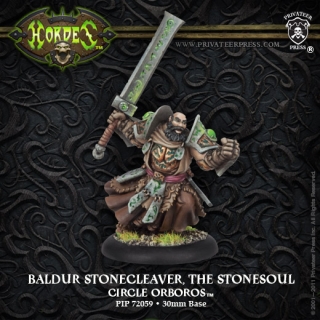Hordes Domination – Circle Orboros Review – Pt. 1: Warlocks

Now that we’ve had Domination in our mitts for a little bit, it’s time for a quick overview with some analysis of the new additions for the Circle Orboros.
Grayle the Farstrider – Grayle is an interesting warlock. At first glance, he seems somewhat unfocused, but the more time I spend with him, the more I see that as being an advantage instead of a weakness. His feat alone provides two significant bonuses that seem difficult to take advantage of at the same time, one granting Warpath to your entire army (allowing you to move one of your models once per turn after you destroy an enemy model) and the other granting Stealth to it. Since Warpath is decidedly an aggressive ability that will put your army up close while Stealth is a defense against ranged and magic attacks from farther than 5″ away, getting the full benefit of both will be pretty unlikely. Instead of looking at his feat as being contradictory, I think it’s important to see it as two different feats that are relatively weaker by comparison to other feats, but more tailorable to the situation. Using his feat will be a matter of choosing what you’re going to want more: mass Stealth or mass Warpath. As there are well over 100 warcasters and warlocks, coming up with new, powerful feats is becoming more and more difficult, and I think that the concept of “either/or”-type feats like Grayle’s opens up some new avenues for Privateer to explore.
Aside from his feat, Grayle has a number of abilities that are of note. Stealth, Sprint, and Side Step grant him both ranged protection and mobility while his paired Weapon Master attacks give him a little bit of punch. His Elite Cadre with Wolves of Orboros also gives them Hunter, effectively letting them ignore forests when declaring charges. It’s not a really big bonus, nor is it a reason to take Wolves by itself, but since Grayle benefits Morraig (see Storm Rager) so well, Wolves will often be present in his builds anyway.
His spell list isn’t terribly exciting at first look, but careful analysis reveals several gems there. Awareness is a pretty dangerous spell all things told, granting battlegroup models 360-degree front arcs and the ability to ignore clouds, forests, and intervening models when determining line of sight. This can come quite in handy for using various wolds to snipe out support solos.
Gallows is a great spell for scalpeling out priority targets, and makes the presence of Druids less of a priority (even though they are pretty solid with him anyway). It makes taking a Woldwarden or Megalith a decent option for Grayle.
Storm Rager is a bit different for Circle players, allowing them to buff the STR, MAT, and ARM of a single warrior model as well as protecting them from combined melee/ranged attacks. It goes great on hard-hitting solos like Wolf Lord Morraig, the Lord of the Feast, Tharn Ravager White Manes, or even Grayle himself. All three of the listed solos become pretty scary with Storm Rager. Morraig jumps up to ARM 19 while mounted with MAT 10 and P+S 15. Stack that with Flank from Wolves of Orboros and Weapon Master and the guy gets 5d6 on the charge, averaging out at a POW 32.5 damage roll. The Lord of the Feast and White Mane become super-effective infantry clearers with fantastic MAT values and the ability to buy additional attacks for every model they kill. Grayle himself jumps up to a MAT 9, ARM 18, P+S 12 Weapon Master with his various combat abilities, making him a fairly effective vector for an assassination run.
Wind Blast will probably be a lesser-used spell for Grayle, but it’ll be handy when you need it, allowing you to remove cloud effects from play and debuff enemy RAT values in a 5″ AOE. It is a little redundant with Awareness, at least for his battlegroup, but it will clear line of sight for infantry and could be handy against ranged forces for denial purposes. This will most likely be his least-used spell, but it can certainly be handy if need arises.
For a 35-point list, I’ll be looking at the following:
Grayle the Farstrider (*6pts)
* Gorax (4pts)
* Warpwolf Stalker (10pts)
* Woldwarden (9pts)
Shifting Stones (2pts)
* Stone keeper (1pts)
Wolves of Orboros (Leader and 9 Grunts) (6pts)
* Wolf of Orboros Officer & Standard (2pts)
Blackclad Wayfarer (2pts)
Wolflord Morraig (5pts)
35-point lists are always a little difficult to write, but I’m liking the feel of this one. The Gorax and Stalker are a fantastic pair, the former’s animus turning the latter into a killing machine that can handle most any circumstance thanks to being able to warp for additional STR for wrecking armor or Berserk for threshing out infantry. The Woldwarden is there for spell support, granting Grayle another means of throwing around Gallows or putting Storm Rager out there without pulling off of Grayle’s Fury. Shifting Stones are great, and are pretty ubiquitous in Circle Lists, providing healing, some movement shenanigans, and getting in the way of your opponent’s forces when you need it. The Wolves of Orboros aren’t the best of infantry choices, but they mesh really well with Wolflord Morraig, providing Flank as well as not being half-bad in melee on their own, particularly when they pop Power Swell for the additional damage die. The Blackclad is present for utility, granting free charges with additional movement or spraying down enemy infantry that get too close.
The 50-point extension of this list would start by adding Druids for the utility that they bring, the Lord of the Feast for Storm Rager, and a Wilder to help with animi and keeping his warbeasts forceable.
Baldur the Stonesoul – Like Grayle, Baldur is odd to look at on-paper. He doesn’t have any particularly obvious combinations that will drive his list builds or play. As his feat relates strongly to one of his spells, I’ll hold off talking about that until a little later.
His ability list has a very unique item in it: Devourer’s Debt, which places a wurm token on him during every Control Phase. Each token on him will grant a +1 STR bonus, but will also cause one point of damage at the end of every activation. This ability alone makes Megalith’s presence a foregone conclusion thanks to the construct’s affinity that will heal Baldur for d3 damage points a turn. While Devourer’s Debt can certainly turn Baldur into a decent beatstick, he doesn’t really have the threat range to back it up unless you’re getting super-creative with Shifting Stone use, so I wouldn’t necessarily assume that he’s going to be doing a lot of clobbering unless it’s late-game or your opponent underestimates him.
eBaldur maintains the Elemental Mastery ability of his former self, allowing him to heal wolds and enabling them to charge or make power attacks without spending focus, which is a pretty large boon for them considering their below-average Fury stats. Free tramples with your Woldwardens and Megalith can give them extra threat range for casting spells if you need it without costing them fury, which Woldwardens are particularly low on.
Baldur’s spell list isn’t overly impressive, but there are some curious choices in there. His first spell is Crevasse, originally found on another Circle warlock, Mohsar the Desertwalker. Unlike Mohsar, Baldur is working with a Fury stat of 6 and not 8, so he won’t get anywhere near the mileage out of the spell that Mohsar does. For the uninitiated, it’s a medium-ranged offensive spell that hits for POW 12. If the target is boxed, you get to make a SP 6 attack origination from the boxed model. It’s a handy infantry killer, but Fury 6 makes the need to boost much higher if you want to reliably kill affected models. It obviously has some synergy with Woldwardens and Megalith, and will likely be used by them via the Geomancy ability.
Ground Zero is another infantry-clearing spell, doing a POW 13 damage roll to all models under a 5″ AOE centered on Baldur himself. Additionally, models in the AOE are pushed away from Baldur 6″. It’s not the most fantastic ability, but it certainly has some value for Baldur, allowing him to not only destroy an infantry jam without even rolling to hit, but to make adjustments to enemy positioning via Ground Zero’s push effect. Using Shifting Stones to get him into position, you can potentially take out a decent swath of infantry if you can afford to risk it.
His third spell is Rock Wall, a spell most commonly associated with Gorten Grundback and Gunnbjorn. It allows him to place a 4″-long linear obstacle completely in his control area. It’s a super-handy spell that has a number of different uses, be it providing cover to ranged and magic attacks, denying model placement, stopping charges from non-pathfinding infantry, granting a +2 DEF bonus to models that are attacked over it in melee, or allowing a warbeast to slam a model into it for extra damage and limited throwing. It’s particularly useful with Woldwardens that take advantage of Chain Attack: Smite, allowing them to slam the model, knock it down, do an additional die of damage, and continue to wail on it as it will have not left its melee range.
Baldur’s last spell is new to the game, Roots of the Earth, a relatively low-cost ARM buff that also makes the target model immune to knockdown and being moved or placed. Since this spell is not an upkeep and does not affect an entire unit, it will most likely be used on Baldur’s warbeasts, solos, and Baldur himself. This is a spell that can be used by Woldwardens and Megalith via the Geomancy ability, granting you a front line of high-ARM rock and wood. Be mindful that models cannot be moved while effected by Roots of the Earth, meaning that you’ll typically want Baldur casting it after his target has moved itself. The fact that it is not an upkeep spell is both a blessing and a curse, since you’ll have to recast it every turn. That said, it can’t be purged via models like Epic Eiryss or the Withershadow Combine, nor by the spell Purification. While thrown on a Wold Guardian, the construct’s ARM value skyrockets to obscene levels.
Baldur’s feat is basically Roots of the Earth on his entire army. This feat can be used both offensively and defensively. You can use it on the turn before your opponent makes a big push, or you can throw it up on the turn that you shove yours down your enemy’s throat. Baldur will most likely want to activate last on the turn you pop his feat, so be mindful of your activation order.
For eBaldur’s 35-point list, I’d probably start with something like this:
Baldur the Stonesoul (*5pts)
* Gorax (4pts)
* Megalith (11pts)
* Warpwolf Stalker (10pts)
Druids of Orboros (Leader and 5 Grunts) (7pts)
* Druid of Orboros Overseer (2pts)
Shifting Stones (2pts)
* Stone keeper (1pts)
Gallows Grove (1pts)
Blackclad Wayfarer (2pts)
Normally, I’d push for more wolds in a Stonecleaver list, but the Stonesoul lacks for damage buffing, so I felt that the Gorax/Stalker combination was pretty important to bring some decent damage output to the table. The rest of the army acts not unlike it does in the Grayle list above.
For the jump to 50 points, I’d add in a Wold Guardian for ranged protection, the crazy ARM value that can be reached via Roots of the Earth, and more punch as well as a Wilder to help keep the Stalker in a position where I can force, heal, and leach from it, another unit of Shifting Stones, and perhaps another two Gallows Groves for channeling as well as Tough and healing denial.
Next time I’ll crack open the rest of the Circle offerings from Domination and give them a look. Stay tuned!




